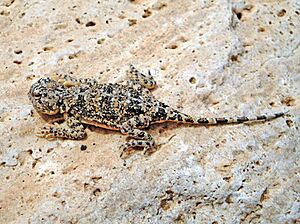Phrynocephalus horvathi facts for kids
Quick facts for kids Phrynocephalus horvathi |
|
|---|---|
 |
|
| Conservation status | |
| Scientific classification | |
| Genus: |
Phrynocephalus
|
| Species: |
horvathi
|
| Synonyms | |
|
|
Phrynocephalus horvathi is a small desert lizard. It is active during the day. This lizard belongs to the Agamidae family. You can only find it in the Aras River valley. Sadly, it is considered Critically Endangered, meaning it is at high risk of disappearing forever.
Contents
Understanding Phrynocephalus horvathi
Scientists study how different animals are related. This is called phylogeny. The Phrynocephalus group of lizards has been a bit tricky to understand. Recently, scientists have learned more about them.
Is it a separate species?
For a while, some thought P. horvathi was a type of P. persicus. But now, many experts, including the IUCN, agree it is its own unique species. This means it is different enough to be its own kind of lizard.
What Phrynocephalus horvathi Looks Like
This lizard is quite small. An adult male is about 48 mm (1.9 in) long from its nose to the start of its tail. Its tail adds another 60 mm (2.4 in) to its length.
Body and Head Shape
The lizard has a thin, flat body. Its head is also flat. This shape might help it hide or move easily in its habitat.
Special Scales
One cool feature is a row of nine scales on its neck. These scales look like tiny thorns. They run down the middle of its neck.
Where Phrynocephalus horvathi Lives
P. horvathi lives in several separate areas. All these places are in the valley of the Aras River. You can find it in parts of Armenia, Azerbaijan, and Turkey. It lives in areas up to 500 meters high.
Its Preferred Home
This lizard loves places with loose sandy soil. It often lives in semi-deserts where there are patches of plants. You might also find it in traditional farm fields.
Protecting Phrynocephalus horvathi
This lizard is listed as "critically endangered." This means it faces a very high risk of becoming extinct. There are a few reasons why this lizard is in so much trouble.
Why it's Endangered
Its populations are scattered and small. Over the last 12 years, about 80 percent of its home has been lost. This loss is mainly because of farming and cities growing bigger. In 2008, scientists estimated there were fewer than 2,000 of these lizards left.
Conservation Efforts
The good news is that P. horvathi lives in at least one official protected area. These areas help keep its habitat safe. Protecting these places is very important for the lizard's survival.


